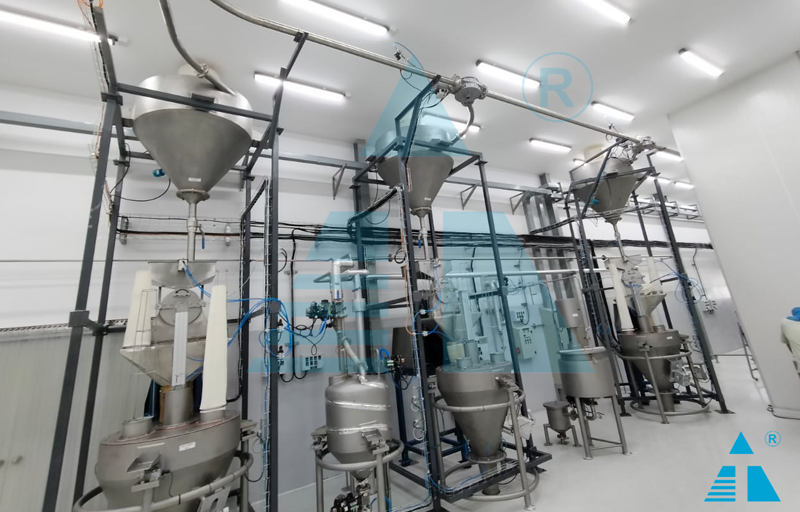How Pneumatic Conveying Systems Help Reduce Dust and Spillage in Factories

In modern manufacturing and processing industries, efficiency and safety go hand in hand. One of the biggest challenges many factories face is handling bulk powders, granules, and raw materials without creating dust clouds or product spillage. Both issues can lead to material wastage, safety hazards, and increased cleaning costs. This is where a pneumatic conveying system becomes a game-changer.
By using compressed air or gas to transport materials through enclosed pipelines, a pneumatic conveying system not only ensures smooth and controlled movement but also helps reduce dust and spillage significantly.
What is a Pneumatic Conveying System?
A pneumatic conveying system is an automated method of moving bulk materials like powders, grains, chemicals, and minerals through pipelines using air pressure or vacuum. Unlike traditional belt conveyors or manual handling, this method is enclosed, dust-free, and designed to minimize material loss.
There are two main types of pneumatic conveying:
-
Dilute Phase Conveying – Uses high-velocity air to move lightweight materials.
-
Dense Phase Conveying – Works at low velocity with high pressure, ideal for fragile or abrasive materials.
Factories choose between these systems depending on the nature of the product and the distance it needs to be transported.
The Problem of Dust and Spillage in Factories
Before diving into solutions, let’s understand the challenges:
-
Dust Hazards – In industries like cement, chemicals, or food processing, dust can pollute the air, affect worker health, and create potential fire or explosion risks.
-
Material Loss – Spillage during transfer means not only wasted raw materials but also higher costs for cleanup.
-
Contamination Risks – In food and pharmaceutical factories, dust and spillage can contaminate products, leading to quality control issues.
-
Maintenance Costs – Frequent cleaning and dust collection add to operational expenses.
Clearly, dust and spillage are more than just a housekeeping problem—they impact safety, efficiency, and profitability.
How Pneumatic Conveying Systems Reduce Dust
One of the strongest advantages of a pneumatic conveying system is its ability to control dust. Here’s how it works:
-
Enclosed System Design
Since materials are transported in sealed pipelines, there’s little to no exposure to open air, which minimizes dust escape. -
Controlled Airflow
By regulating pressure and velocity, the system ensures smooth material flow without creating dust clouds. -
Reduced Manual Handling
Less manual loading and unloading means fewer chances for materials to spill or scatter into the air. -
Integration with Dust Collection Systems
Many pneumatic conveyors are designed to work with filters or cyclones, further capturing fine particles.
How Pneumatic Conveying Systems Minimize Spillage
Spillage is another costly issue in factories, especially when handling expensive raw materials. A pneumatic conveying system helps reduce spillage by:
-
Direct Material Transfer
Materials are moved directly from source to destination without intermediate handling points. -
Automation and Precision
Automated feeding reduces human error, which is one of the leading causes of spillage. -
Customizable Flow Control
Adjustable airflow ensures the system can handle both fragile and abrasive materials without damage or leakage. -
Sealed Pipelines
The enclosed network prevents materials from falling, even when transported over long distances or complex layouts.
Benefits Beyond Dust and Spillage Reduction
While dust control and spill prevention are major benefits, factories also enjoy additional advantages when using pneumatic conveying systems:
-
Improved Worker Safety – Cleaner air reduces respiratory risks and creates a safer work environment.
-
Better Hygiene – Essential in industries like pharmaceuticals and food processing, where contamination control is critical.
-
Higher Efficiency – Automated conveying means faster transfer rates and less downtime.
-
Space Saving – Pipelines can be routed vertically or horizontally, unlike bulky mechanical conveyors.
-
Cost Savings – Reduced waste, lower cleaning needs, and less equipment maintenance all translate into long-term savings.
Industries That Benefit Most from Pneumatic Conveying Systems
Different industries have unique needs, but many can benefit from this technology:
-
Cement & Construction – To handle cement, fly ash, and lime without dust clouds.
-
Food & Beverage – For flour, sugar, grains, and other ingredients.
-
Pharmaceuticals – To ensure sterile, dust-free handling of powders and chemicals.
-
Chemical Processing – For powders, resins, and raw chemicals that require safe handling.
-
Plastics & Polymers – For conveying plastic pellets and powders efficiently.
Key Considerations When Choosing a Pneumatic Conveying System
If you’re planning to invest in this system, consider the following factors:
-
Type of Material – Fragile, abrasive, or sticky materials may need different conveying modes.
-
Distance and Capacity – Longer distances and higher capacities require more robust systems.
-
Energy Efficiency – Look for systems optimized to reduce compressed air consumption.
-
Maintenance Requirements – Choose a design that offers easy cleaning and minimal downtime.
Conclusion
In factories where dust and spillage have long been accepted as unavoidable, a pneumatic conveying system offers a smarter and safer alternative. By transporting materials in a controlled, enclosed environment, these systems not only protect workers and products but also reduce waste and operational costs.
- AI
- Vitamins
- Health
- Admin/office jobs
- News
- Art
- Causes
- Crafts
- Dance
- Drinks
- Film
- Fitness
- Food
- Oyunlar
- Gardening
- Health
- Home
- Literature
- Music
- Networking
- Other
- Party
- Religion
- Shopping
- Sports
- Theater
- Wellness


